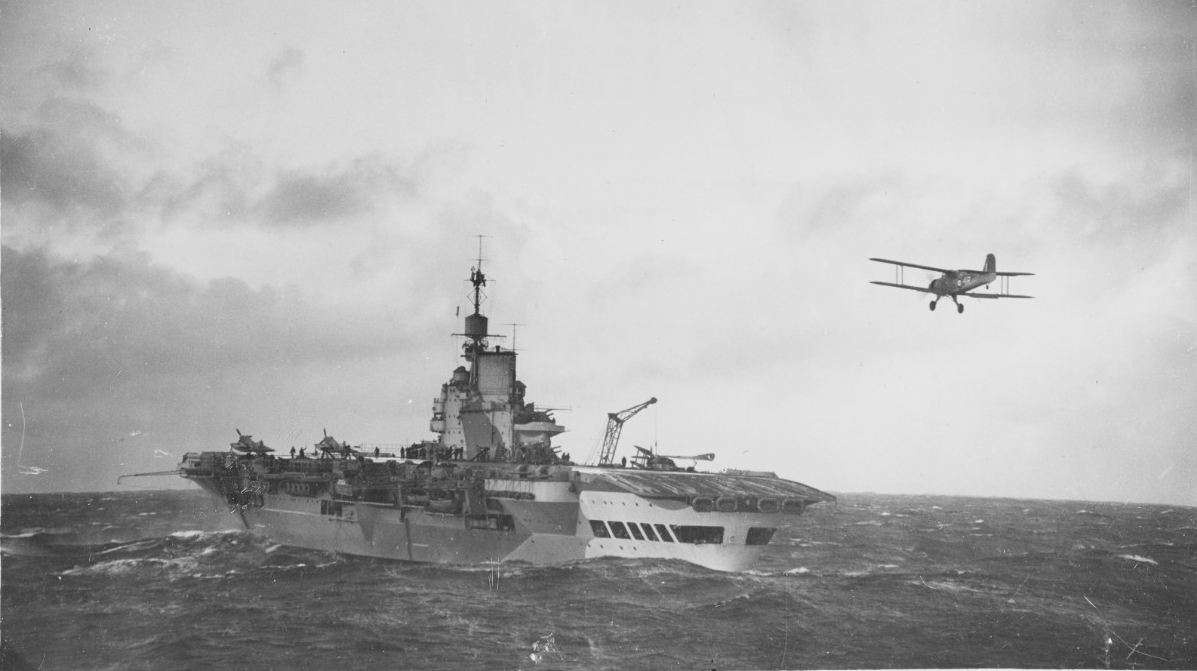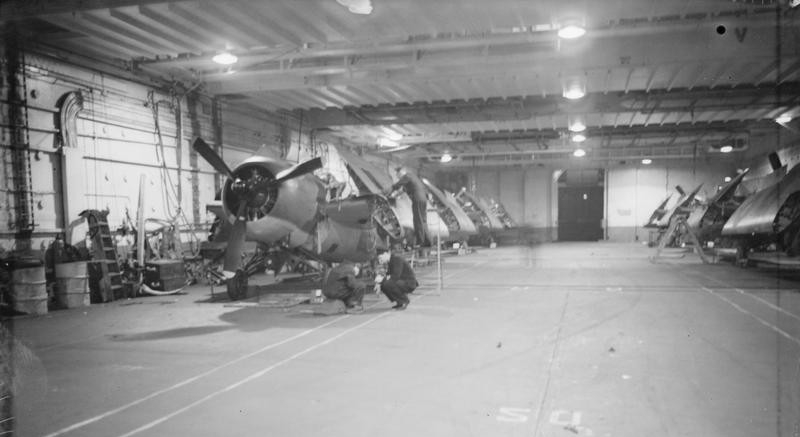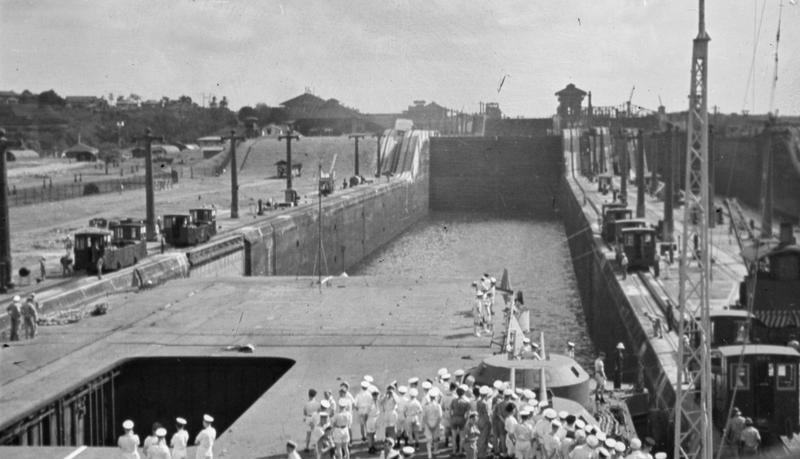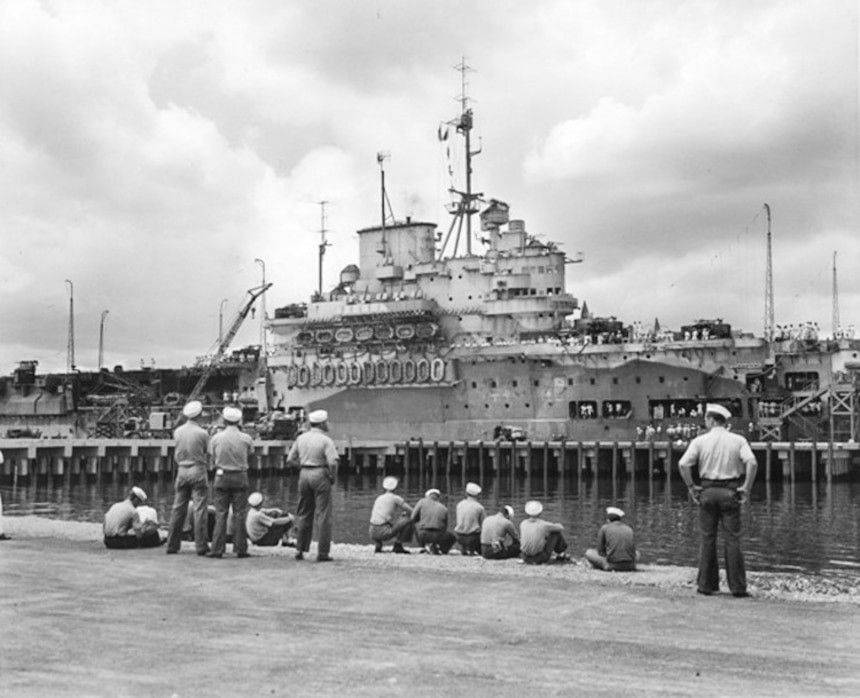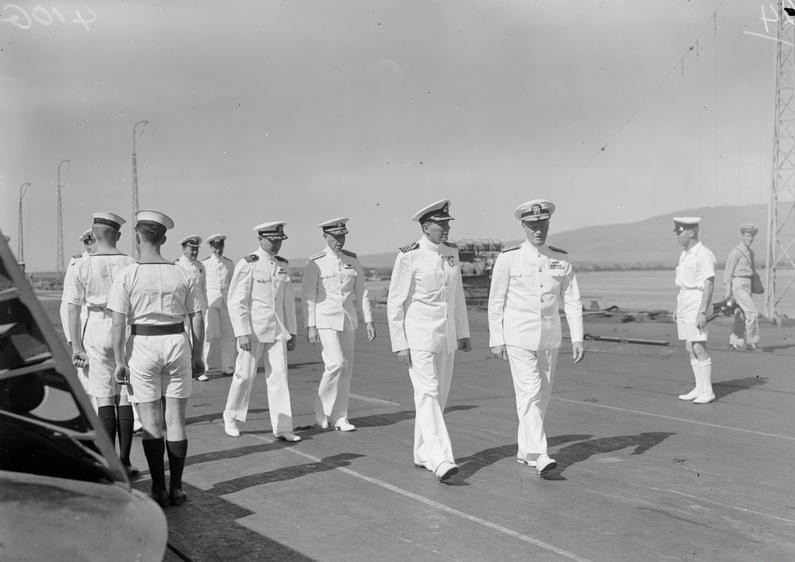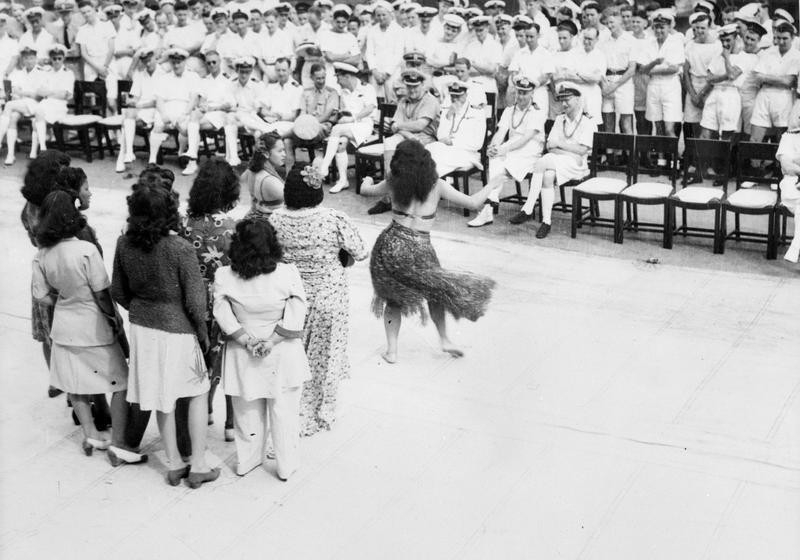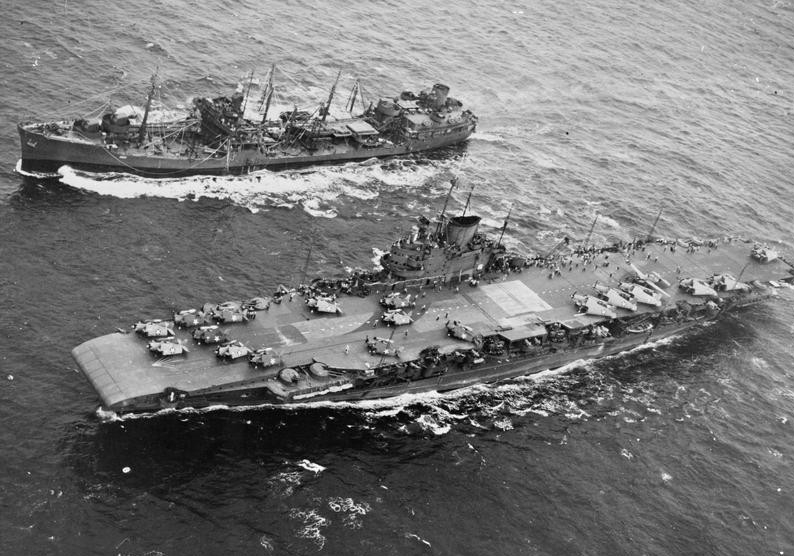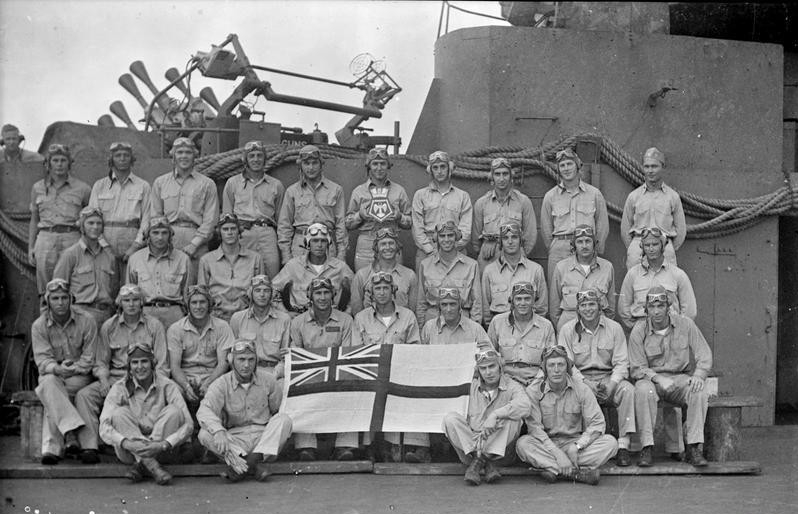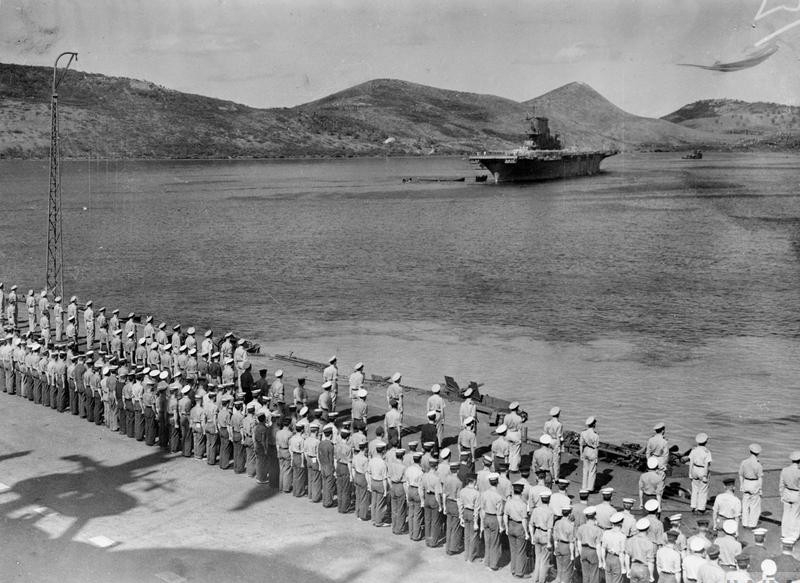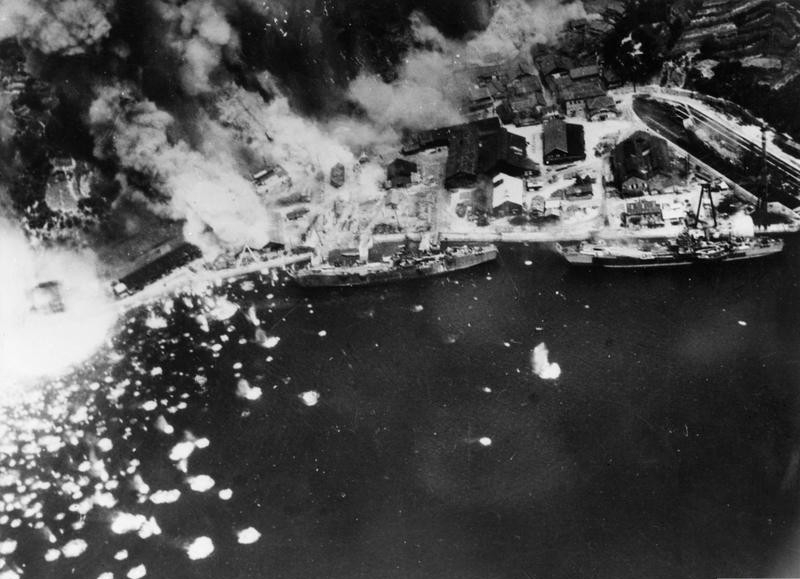"USS Robin": When the CNO Needed a Royal Navy Carrier
HMS Victorious in the Pacific, 1943
In autumn 1942, Admiral Ernest J. King, the Chief of Naval Operations and Commander-in-Chief U.S. Fleet, faced a dilemma: The battles of the Coral Sea and Midway, and the still-ongoing Guadalcanal campaign, had severely weakened the U.S. Navy's fleet carrier presence in the Pacific. Lexington (CV-2) had been lost at Coral Sea, Yorktown (CV-5) at Midway, and Hornet (CV-8) during the Battle of Santa Cruz Islands. Wasp (CV-7) had been torpedoed and sunk south of the Solomons in September. Although it remained operational, Enterprise (CV-6) had been repeatedly damaged during the naval engagements around Guadalcanal and would eventually require repairs at a U.S. shipyard. Saratoga (CV-3), which had also been damaged in the Solomons, was undergoing repairs at Pearl Harbor. Ranger (CV-4), despite taking part in the Allied landings in French North Africa in November (Operation Torch), was not deemed suitable for combat in the Pacific due to its light hull construction. The first new Essex-class carriers were not expected to join the fleet until late 1943. Saratoga would be operational again by the new year, but additional carrier support was needed to counter Japanese naval forces during the anticipated offensive drive up the Solomon Islands chain. This situation would ultimately lead to an interoperability arrangement with the Royal Navy that was unique in many ways at this stage of the conflict.
Contrary to some portrayals, King was no Anglophobe. As a captain, he had taken part in Royal Navy operations and fleet exercises during the latter part of World War I and had always evaluated the experience positively. Moreover, as a personal sartorial touch more in line with Royal Navy than U.S. Navy uniform regulations, King often carried a white pocket square in the breast pocket of his service dress blue uniform jacket. If King showed impatience or was perceived as intolerant toward the British during the war, it was in his plain-spoken view that the operational and strategic objectives advocated by his counterparts on the Imperial General Staff at times appeared unrealistic or ignored the need to counter Japan in the Pacific. However, King’s unvarnished approach did not preclude requesting assistance from his Allied counterparts.
In June 1942, soon after the Battle of Midway, King had asked the British Admiralty to detach at least one carrier to the U.S. Pacific Fleet, but the Royal Navy's flattops were heavily engaged against the Axis in the Atlantic, Mediterranean, and the Indian Ocean at the time. Now, in late October, he again raised the issue and it quickly made its way from the British Admiralty into personal communications between Prime Minister Winston Churchill and President Franklin D. Roosevelt. Thus, following Operation Torch, and despite its continuing operational commitments, the Royal Navy detached the carrier HMS Victorious from the Home Fleet for service with the U.S. Navy.
A view of Royal Navy Martlet IVs (F4F-4 Wildcats) in Victorious’ armored hangar deck, September 1942. The British pre–World War II decision to armor the flight decks and hangars of its newer aircraft carriers—contrary to U.S. Navy designs—was based on expectations of fighting a future war within European waters against powerful enemy surface forces (Imperial War Museum A 12556).
In a number of ways, Victorious, a second-generation Royal Navy carrier, differed significantly from its U.S. counterparts. The British Admiralty, with its primary focus on operations in the Atlantic and Mediterranean, had integrated fully enclosed armored hangars and flight decks into the requirements of the Illustrious class, of which Victorious was the second ship. Although the British carriers embarked fewer aircraft, the survivability of these units and their embarked air wings during attacks by capital ships and land-based medium and heavy bombers was a primary consideration. In contrast, contemporary U.S. Navy aircraft carrier design drew on lessons learned from interwar tabletop war games at the Naval War College and its annual Fleet Problems, which concentrated on a future war in the Pacific. It featured traditional armored hulls with unarmored hangars and flight decks—the former to accommodate a maximum number of aircraft and the latter to facilitate temporary repairs of battle damage inflicted by opposing forces during operations. On U.S. carriers commissioned after Ranger (1934), elevators were configured on the ships’ sides—in contrast to Royal Navy pre-war designs, in which elevators were generally placed along a ship’s centerline. This allowed U.S. carriers to embark a greater number of aircraft. Moreover, their lighter-built and well-ventilated hangar decks allowed aircraft to be run up in the hangar during maintenance, a procedure that was not possible in enclosed British hangars. Thus, although Royal Navy aircraft may have been better protected, this limitation could affect their serviceability rates. The U.S. carrier design approach had proven itself in the Pacific through 1942. (The type of ship-killing damage caused by Japanese kamikaze aircraft would not be experienced until 1944).
Victorious had been commissioned on 29 March 1941. On 22 May, with only half of its aircraft compliment embarked, the carrier was hurriedly deployed in the hunt for the German battleship Bismarck, which was subsequently located in the Denmark Strait, heading for the Atlantic sea lanes. Late on the 25th, one of Victorious’ Fairey Swordfish torpedo bombers scored a hit, albeit on Bismarck’s armored anti-torpedo belt. As the carrier’s homing beacon had failed, it took no further part in the pursuit and sinking of the German ship. Victorious subsequently escorted several Arctic convoys and, in August 1942, the Operation Pedestal convoy, during the Royal Navy’s relief and resupply of Malta. On 4 November, the carrier supported Operation Torch before returning to the British Home Fleet in Scapa Flow, Scotland, in the latter part that month. Upon being directed to join the U.S. Pacific Fleet, the carrier was replenished at Greenock, Scotland, and departed British waters with her escorts (a cruiser and three destroyers) on 20 December. Victorious made a brief port call in Bermuda, and arrived at Norfolk, Virginia, on the last day of 1942.
At Norfolk, Victorious was in dry dock until 31 January 1943. She was fitted with the U.S. Navy’s TBS (“Talk Between Ships”) system, new surface- and air-search radars and respective vertical plotting board, the U.S. YB-type aircraft-homing system, and two U.S. cypher machines. The ship's stern was modified with a flight deck extension accommodating a new “7 wire” and providing additional deck park space. Additional antiaircraft guns, both 20mm Oerlikons and quad 40mm Bofors, were added. A U.S. Navy Mark 51 fire-control director was sited on the gallery deck amidships on each side. A new fire-suppression system was installed in the crew spaces and a control station added to the hanger deck.
On 1 January 1943, Victorious’ obsolescent Fairey Albacore torpedo bombers were flown off to Norfolk Naval Air Station and replaced with new U.S. TBF Avengers. Work-ups with these were conducted at Naval Air Station Norfolk. To accommodate these much heavier aircraft, the arrestor wires were strengthened. All embarked aircraft received U.S. national insignia, but retained either Royal Navy or U.S. Navy camouflage schemes. A 35-man U.S. naval aviation liaison team was embarked to acquaint its British counterparts with U.S. take-off, landing, and shipboard aircraft-handling signals and practices. Specialists on the team familiarized the British crew with U.S. Navy communications and encryption procedures, which would henceforth be in use. In anticipation of combat service in the tropics, Royal Navy personnel were issued U.S. Navy khaki and dungaree shipboard working uniforms to be worn in lieu of the British tropical whites.
Victorious departed Norfolk on 3 February en route to the Panama Canal and was assigned the U.S. Navy two-syllable call sign “Robin.” Intensive flight operations utilizing U.S. Navy procedures, both with Martlets and the still-unfamiliar TBFs, continued during the carrier’s transit to the canal and resumed once the ship had entered the Pacific on 14 February and headed for Pearl Harbor, escorted by three U.S. destroyers. During the passage to Hawaii, 184 Martlet and 60 Avenger sorties were flown. Difficulties were encountered with the latter aircraft, particularly during landing operations, in part because the TBFs’ arrestor hooks had too narrow a “throat” for the standard British wires. Moreover, the tensioning of the wires was unsuitable for potential off-center landings by the large Avengers. Several landing accidents, two of them fatal, occurred. Finally, the aircraft were too heavy when fully loaded to be lifted by either of the ship's cranes and required precise positioning to fit on Victorious' elevators. Royal Navy personnel also became acquainted with the U.S. Navy’s methods of handling aircraft on the flight deck.
“Robin” arrived in port at Pearl Harbor on 4 March. Here, the arresting gear was altered to trap the TBFs more effectively. The arrestor hooks of the embarked torpedo bombers were modified to better catch the arrestor wires. Nonetheless, issues with the Avengers persisted during work-ups, culminating in a flight deck crash and fire on 25 April. The damage was subsequently repaired at Pearl Harbor. Aside from its flight deck surface, the ship’s Royal Navy disruptive camouflage pattern was overpainted in U.S. Navy sea blue, matching Saratoga, which was slated to be the British carrier's consort during upcoming operations in the central Solomons. On 8 May, together with North Carolina (BB-55) and two destroyers, Victorious departed Pearl Harbor and headed for the South Pacific.
HMS Victorious in port at Pearl Harbor shortly after her 4 March 1943 arrival. Soon after, the British disruptive camouflage would be overpainted with sea blue, the U.S. Navy Measure 11 specification. Victorious was an object of curiosity for U.S. Navy personnel of all ranks (National Archives 80-G-276610).
On 17 May, Victorious reached Noumea, New Caledonia, and joined Saratoga in Rear Admiral DeWitt Ramsey’s Carrier Division ONE (CARDIV 1). CARDIV 1 was part of Task Force 14 (TF 14), which included the battleships North Carolina, Indiana (BB-58), and Massachusetts (BB-59). At this point, “Robin” and Saratoga were the only operational Allied carriers in the Pacific. Barely a day later, TF 14 got underway when it appeared that Japanese fleet units were departing their base at Truk in the Caroline Islands. Although the reporting turned out to be erroneous and the carriers returned to Noumea on 24 May, Victorious’ first deployment with an operational U.S. Navy task force was beneficial for both British and American crews. Victorious’ superior fighter direction, founded on extensive combat experience in the Atlantic and Mediterranean, was noted by all. Some details of the British procedures were subsequently adopted by the U.S. Navy.
In early June, “Robin” and Saratoga conducted interoperative exercises off Noumea using U.S. Navy flight procedures, including cross-decking each other’s aircraft. Despite its modifications, the space limitations of Victorious continued to affect the handling of the TBFs. Thus, it was decided to embark Saratoga’s VF-3 on Victorious, and the British carrier’s 832 Squadron with its Avengers on Saratoga. Accordingly, during the time that the two ships operated together, Saratoga would provide naval strike assets (retaining 12 fighters for combat air patrol), while Victorious would only embark fighters.
Victorious carrying out replenishment at sea (RAS) with USS Cimarron (AO-22), 12 July 1943. Note the F4F-4 fighters in U.S. Navy (light) and Royal Navy (dark) camouflage on deck—the result of the cross-decking VF-3 from Saratoga. The light-colored square on the flight deck just beyond the carrier’s island is a painted decoy elevator (Imperial War Museum A 21746).
As part of Rear Admiral Forrest P. Sherman's Task Group 36.3, the carriers left Noumea on 27 June to take part in Operation Toenails, the invasion of New Georgia. The task group was not involved in the amphibious landings themselves, but instead remained on station for 28 days to provide air cover for the transports and landing forces. The British crew’s extensive training in U.S. procedures and the mutual exchange of practical experience paid off as U.S. and Royal Navy sailors kept patrol aircraft in the air for nearly 12 hours per day. Victorious was also able to gain experience in the U.S. Navy’s abeam replenishment-at-sea (RAS) operations. (In other theaters of operations, Royal Navy ships generally returned to large fleet bases for resupply. When conducted, RAS was accomplished by the astern method, which was slower, but required less precision.) Surprisingly, no contacts with the Japanese occurred during this period. The task group returned to Noumea on 25 July.
Victorious on 27 July 1943, four days before departing Noumea, New Caledonia, and detached service with the U.S. Navy. The Royal Navy personnel mustered on the flight deck retain the U.S. Navy shipboard working uniforms originally issued at Norfolk: khakis for officers, dungarees for enlisted sailors, worn with Royal Navy covers. Saratoga, Victorious’ consort during the New Georgia campaign, may be seen in the background (Imperial War Museum A 19653).
On 31 July, “Robin” detached to rejoin the British Home Fleet by way of Pearl Harbor, San Diego, the Panama Canal, and Norfolk, where her U.S. Navy communication systems, radar, and flight operations gear were removed. On 27 September, she arrived in Liverpool for a lengthy refit that lasted until the following March. Following strikes against the German battleship Tirpitz off Norway (Operation Tungsten) in April 1944 and subsequent operations with the British Eastern Fleet in the Indian Ocean, Victorious returned to the Pacific in February 1945. As a unit of the newly constituted British Pacific Fleet (BPF), it took part in Operation Iceberg (1 April–22 June), the invasion of Okinawa. The BPF, operating with the U.S. Fifth Fleet as Task Force 57, primarily concentrated its surface and air assets on striking and isolating the Sakishima islands, southwest of Okinawa in the Ryukyus chain. On 9 May, Victorious was struck by two kamikaze aircraft, both of which “bounced” off her armored flight deck. Despite damage to the flight deck plating, the ship’s one catapult, its forward elevator, two 4.5-inch guns, and several parked aircraft, the carrier resumed flight operations within hours of the strikes. (In contrast, the U.S. Navy’s Essex-class carriers Franklin [CV-13], which had been severely damaged by a kamikaze that March, and Hancock [CV-19], hit by a kamikaze during Iceberg, had to withdraw completely from combat operations.) Nonetheless, additional damage caused to barrier gear by flight deck accidents during the Okinawa operations finally necessitated in-port repairs. Along with other battle-damaged BPF units, Victorious arrived in Sydney, Australia, at the end of May. On 4 July, the carrier rejoined the BPF—now operating with U.S. Third Fleet as Task Force 37—at Manus, Admiralty Islands. It returned to Japanese waters, where its air wing conducted strikes on the Japanese home islands until the Japanese acceptance of Allied surrender terms on 15 August.
Unlike many Royal Navy ships, Victorious was retained on active service after the war. Extensive reconstruction and modernization begun in October 1950 dismantled the carrier’s hull down to hangar deck level and entailed major structural changes to many compartments to accommodate new auxiliary machinery, magazines, and aviation fuel storage. Victorious, with a new angled flight deck, finally came out of dry dock in January 1958, having missed Korean War operations and Operation Musketeer, the temporary Anglo-French seizure of the Suez Canal from Egypt in November 1956. The “new” Victorious was significantly smaller than the U.S. Navy’s new Forrestal class of super carriers, but possibly had superior radar and aircraft direction capabilities. It also served as a testbed for the modernization of other Royal Navy carriers and provided design lessons for future British platforms. In November 1967, during a refit in Portsmouth, England, an overheated tea urn caused an onboard fire that damaged some electrical systems and resulted in one casualty. Although the refit remained on schedule and the ship still had a viable service life, Prime Minister Harold Wilson’s government instead decided to scrap it in the course of Royal Navy force reductions. Victorious’ ensign was lowered on 13 March 1968 and the carrier was subsequently broken up in Faslane, Scotland.
—Carsten Fries, NHHC Communication and Outreach Division
Further Reading
Beaver, Paul. The British Aircraft Carrier. Cambridge, UK: Patrick Stephens, 1982.
Buell, Thomas B. Master of Sea Power: A Biography of Fleet Admiral Ernest J. King. Boston: Little, Brown and Company, 1980.
Friedman, Norman. Winning a Future War: War Gaming and Victory in the Pacific War. Washington, DC: Naval History and Heritage Command, 2018.
Hobbs, David. The British Pacific Fleet: The Royal Navy’s Most Powerful Strike Force. Barnsley, UK: Seaforth Publishing, 2011.
———. Aircraft Carrier Victorious—Detailed in the Original Builders’ Plans. Barnsley, UK: Seaforth Publishing, 2018.
Hone, Thomas C., Norman Friedman, Mark D. Mandeles. American & British Aircraft Carrier Development, 1919–1941. Annapolis, MD: Naval Institute Press, 1999.
Konstam, Angus. British Aircraft Carriers 1939–45. Botley, UK: Osprey Publishing, 2010.
The privately maintained website armouredcarriers.com offers primary source documents related to the deployment, to include after-action reports by the carrier’s commanding officer, Captain L. D. Mackintosh, RN, and by the U.S. Navy liaison officer, Commander S. G. Mitchell, USN.

